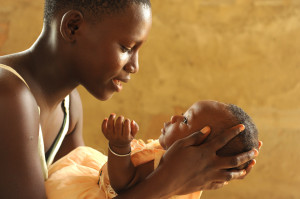 There is one institution on earth with the capacity, the presence, the credibility, the endurance, and the passion to perform the ultimate act of caring for the poor. It is the church, the body of Christ.
There is one institution on earth with the capacity, the presence, the credibility, the endurance, and the passion to perform the ultimate act of caring for the poor. It is the church, the body of Christ.
The world’s largest corporation is China Petro-Chemical, which boasts a labor force of 1.19 million employees. The church is at least a thousand times larger. The church is the only organization with hundreds of millions of members and the capacity to mobilize hundreds of millions of volunteers. I’m not just talking about the good people serving in soup kitchens—I’m talking about deployment of agents into every sector of society. Agents aligned by one Spirit and a shared hope, drawing on immeasurable riches to achieve what cannot be done alone.
Dr. Ed Green, Harvard medical anthropologist, writes of East Africa:
Churches are found in nearly all communities in the region and wield a significant level of cultural, political, social, educational, and economic influence. The church can be viewed as the largest, most stable and most extensively dispersed non-governmental organization in any country. Churches are respected within communities and most have existing resources, structures, and systems upon which to build. They possess the human, physical, technical, and financial resources needed to support and implement small- and large-scale initiatives. They can undertake these actions in a very cost-effective manner, due to their ability to leverage volunteer and other resources with minimal effort.(1)
The church is unrivaled in its capacity. If you want to respond to the massive challenges of global poverty, then the church is the organization with the legs to get it done.
McDonald’s is also an impressive institution, with about 30,000 outlets worldwide, but local churches outnumber the hamburger empire by nearly 100 to one. The service delivery points of local churches greatly outnumber the branches of government, as does human capacity. In some African countries, up to 70 percent of healthcare is delivered by private Christian organizations, and those services are of superior quality to government-run hospitals and clinics. We have a similar history here in the US. How many “St. Someone” hospitals are in your town?
Churches exist in exactly the right locations to serve the poor. In the slums, in the villages, and in the city centers—the church is present everywhere.
But presence is about more than numbers. Presence must also be strategic in location. Churches exist in exactly the right locations to serve the poor. In the slums, in the villages, and in the city centers—the church is present everywhere. The church is not simply there physically either; its members are integrated within the community. The church is salt and light. It is woven into the fabric of local society, and it has been since its earliest days.
Consider this statement written by Tertullian to describe the Christians around 200 AD:
Do we not dwell beside you, sharing your way of life, your dress, your habits and the same needs of life? We are no Brahmins or Indian gymnosophists, dwelling in the woods and exiled from life. . . . We stay beside you in this world, making use of the forum, the provision-market, and all other places of commerce. We sail with you, fight at your side, till the soil with you, and traffic with you; we likewise join our technical skills to that of others, and make our works public property for your use.(2)
The church is present not only geographically and socially but also through time as a uniquely durable, local outpost of the body of Christ. The church has outlasted every corporation, every nation, and every empire. While we envy corporations that are built to last, not one even comes close to the staying power of the church. The church was there before the AIDS pandemic, through it, and you can count on the church being there when that dreaded disease is finally brought to its end. The church is the bride of Christ (Revelation 19:7–8), and she will stand with him in eternity. If she does not defeat AIDS directly, she will certainly outlast it.

physical wellbeing of children so that they may develop into strong, Christ-filled leaders in their communities.
The church also has street cred. In 2006, a Gallup poll was conducted to discover which organizations Africans trusted and distrusted the most. The poll, conducted in 19 countries, found that they were most likely to trust their churches and least likely to trust their governments. The study concluded that channeling aid through local churches may be more likely to maximize hope among the people.(3)
How the US church started working for the government
In the 1930s the New Deal turned a local and relational appeal for help—“Brother can you spare a dime?”—into a raft of government welfare programs and entitled attitudes. In some ways, the US government became a competitor with the church for the social role of caring for the poor. Not long after that, World War II destroyed much of Europe, so the US government launched major US foreign aid programs to rebuild it. These programs later evolved into our current federal anti-poverty programs.
Churches responded to the trends of philanthropy in the early 20th century, to the conditions of the Great Depression, World War II, and the Korean War. As a result, the 20th century witnessed the foundation of many nongovernmental organizations (NGOs). The Catholics launched the Catholic Relief Services, the Lutherans started Lutheran World Relief, the Mennonites started the Mennonite Central Committee, the Reformed Church started the Christian Reformed World Relief Committee, and so on. Evangelicals launched World Relief as an arm of the National Association of Evangelicals, and organizations like Compassion International and World Vision were born. Most 20th-century NGOs began as Christian organizations. But then something happened.
After Europe was rebuilt, the “aid community” began to turn its attention and budgets toward poverty alleviation. The US government needed capacity, presence, and local credibility to implement anti-poverty work in those contexts. In other words, it needed the church and, specifically, the parachurch agencies that she created. The government began offering grants to organizations that could carry out this type of work. But the money came with a catch called “separate time, separate place,” which prohibited these organizations from providing “religious instruction” while engaging in their government-funded anti-poverty activities. In other words, Christian organizations can administer the vaccine or provide the antibiotic, but they are not allowed to talk about what motivates them, what truth they hold most dear, or what they believe will heal the deeper pains of poverty. If you have to talk about those things, says the government, then do it in a separate time and place. It’s like telling Jesus, “By all means heal the leper, but don’t say, ‘Follow me.’”
Many Christian organizations saw opportunity in this government funding, saying to themselves, “Those are my tax dollars, and I want to do some good with them!” Most of those organizations were struggling on lean budgets, so between 1950 and today many of them began receiving federal grants that required them to accommodate “separate time, separate place.” By legal contract, the proclamation of the good news was to be separated from its demonstration.
Multiple forces, including government funding, conspired to advance a dualistic(9) philosophy within Christian work. These forces pressured NGOs toward secularization of their work, which had various degrees of impact on parachurch programs. Some capitulated and are today entirely secular, while others are still running their races well, with their eyes fixed on the Pioneer and Perfecter (Hebrews 12:2). These secularizing forces are like a gravity field that pulls the Christian organizations in with money and then shreds their core commitments.
Even if you were an atheist, thought the Bible was total hogwash, but wanted to effectively help the poor, you’d be a fool to overlook the church. It has the largest labor force gathered in the very locations you’d wish to reach, speaks the language, and possesses local credibility—everything necessary for effective action. Not to mention the church’s strong moral commitment to integrity, honesty, and countless other virtues gained in its unprecedented track record for perseverance in such service.
Without question, the church continues to conduct important anti-poverty work. Churches support the comprehensive needs of human development, which builds human capital. Churches offer moral foundations, which build social trust, relationships and the hope needed for communities to overcome immense challenges. These intangibles build social and leadership capital. The church is also an instrument that shapes public thought and engagement on important issues, such as environmental stewardship, social injustices, or discrimination toward minority groups and women.
The root of poverty is the insidious and fatalistic lie that whispers, “You can’t. You don’t matter, and it isn’t going to get any better.” What institution carries the truth that defeats that lie? Who proclaims the message that “with God you can”? Who declares, “You do matter and it can get better because God really does love us”? Who offers the only foundation of durable hope? It’s the church.
But these are strategic reasons why the church plays a critical role in ending poverty. You might think I’m arguing that the church’s strategic assets are its strength, but they are secondary. The ultimate reason that the church is critical to the work of ending poverty is the promise of Jesus. Jesus was given the government option and declined. Jesus could have started a business for social good, but he didn’t. Instead he established the church and promised that “the gates of hell shall not prevail against it” (Matt. 16:18). The church, expressed in local, disciple-making communities, is commissioned by Jesus and empowered by the Holy Spirit to advance the kingdom on earth. And that advance includes the eradication of the evil of extreme poverty. No other organization was founded by Christ or carries the promise of victory against the forces of hell.
Revolutionary love
Early Roman Christians had a reputation for their concern for the poor, the sick, and the vulnerable. Just like Jesus. Just like Stephen. The early church historian Eusebius describes the actions of the second-century Christians when plagues struck the city:
The most of our brethren were unsparing in their exceeding love and brotherly kindness. They held fast to each other and visited the sick fearlessly, and ministered to them continually, serving them in Christ. And they died with them most joyfully, taking the affliction of others, and drawing the sickness from their neighbors to themselves and willingly receiving their pains. And many who cared for the sick and gave strength to others died themselves having transferred to themselves their death.(4)
These Christians did not flee the sick and their dreadful infections. Instead they demonstrated “exceeding love and brotherly kindness.” They ministered to the sick fearlessly and died with them joyfully. This type of love was unprecedented in the culture of Roman paganism. It was revolutionary.
Historian James Hunter explains in his book To Change the World that when the early church leaders declared themselves to be “lovers of the poor,” they offered a new model of society: “The care of the poor emphasized a very different and more universal bond of social solidarity, namely, a common humanity.”(5)
You might think that the leaders of Rome would welcome these social services. But many did not. Instead they felt threatened by the new faith and its superstitious adherents. And they tried to stamp out the movement with persecution, including public executions in which Christians were shredded and eaten by lions. The Colosseum. The threat of love again faced violence from the kingdom of darkness.
What if those second-century Christians could see us now? Those who were “exceeding in their love and kindness” during the plagues—who “visited the sick fearlessly” and “died with them most joyfully.” What would they have done to obtain a simple antibiotic on behalf of a sick kid today? How far would they have gone for a net to protect a child from mosquitoes infected with malaria? What if they could see us now? Perhaps they can. Perhaps they are among the “great cloud of witnesses” described in Hebrews 12:1.
God’s movement persisted. The persecution did not stop the Christians from serving the poor, the sick, and the marginalized.
And Julian, the last pagan emperor of Rome, found it infuriating. He thought he was being tricked, that the Christians had invented a new strategy to secure social power by pretending to care for people. So Emperor Julian, threatened by these devious, power-hungry Christians, decided to beat them at their own game. He launched competing social services operated by the pagan priests. But competing with Christian compassion was a frustrating business. Julian wrote:
These impious Galileans not only feed their own poor, but ours also; welcoming them into their agape, they attract them, as children are attracted, with cakes . . . Whilst the pagan priests neglect the poor, the hated Galileans devote themselves to works of charity, and by a display of false compassion have established and given effect to their pernicious errors. See their love feasts, and their tables spread for the indigent. Such practice is common among them, and causes a contempt for our gods.(6)
A modern translation might read, “Those d*** Christians are tricking people into joining their stupid movement by pretending to care about people. They’re even throwing parties for the losers!”
What a wonderful reputation. And so Julian, the godhead of the most powerful empire on earth, stewed like the Grinch over the charitable acts of impoverished migrant workers.
Thus the Christian movement flourished. Baylor sociologist Rodney Stark offers a perspective of the Christian impact on society during this thriving season:
Christianity revitalized life in Greco-Roman cities by providing new norms and new kinds of social relationships able to cope with many urgent urban problems. To cities filled with the homeless and impoverished, Christianity offered charity as well as hope. To cities filled with newcomers and strangers, Christianity offered an immediate basis for attachments. To cities filled with orphans and widows, Christianity provided a new and expanded sense of family. To cities torn by violence and ethnic strife, Christianity offered a new basis for social solidarity. And to cities faced with epidemics, fires, and earthquakes, Christianity offered effective nursing services.(7)
That description could easily be written today about Christianity across Africa. Christianity is helping many Africans cope with the economic pressures driving urbanization, the brutality of poverty, and the painful realities of AIDS, malaria, and other diseases.
Christians are still caring for the orphans, the widows, and the disenfranchised in the hardest places.
I’ve met pastors in India who have rescued baby girls left to die in modern acts of infanticide. I’ve walked the slums of Africa with Christian social workers to visit women infected with HIV as a result of their now-dead husbands’ infidelity. I’ve witnessed the work of Asian and African Christians—doctors, nurses, lawyers, counselors, teachers, business leaders, communicators—and am inspired and humbled by their persevering services for the vulnerable. I personally know African Christian colleagues who have adopted children despite their own meager incomes. Perhaps you have also met such people.
Today there are still a lot of nobodies in the movement—thousands of anonymous “Mother Teresas.” The movement Jesus started is pressing forward—still living the faith with fearless love.
Even if you were an atheist, thought the Bible was total hogwash, but wanted to effectively help the poor, you’d be a fool to overlook the church.
Who are we working for?
Sometimes in the context of development work with the poor, there seems to be a hesitation about sharing the good news of Jesus. A spirit of Emperor Julian lingers in our midst—not only within our culture, but even within the church. As the movement of “impious Galileans” remains steadfast in its service to the poor, Julian continues to accuse us of tricking people into our “stupid faith” by pretending to love them. The spirit of the last pagan emperor of Rome will continue to win tragic victories if we let his accusations stick. God will judge our hearts if there is any hint of coercive power in our assistance. If we offer grace with conditions or love with qualifiers, then we do not love as Christ loves. But if we don’t tell them about Jesus,(8) what will we truly accomplish?
It is clear that government funding of Christian organizations often reinforces the voice of Julian. Treat the infection, but don’t tell them God cares about them. Teach the job skill, but don’t pray for a job. Encourage, but make sure your portrait of hope is godless. Help, but don’t say why. The government’s demand for separation (See “How the US church started working for the government,” above, in green font) runs a sword through the middle of holistic, Christian work—a demonstrated and proclaimed good news. This is an extremely complex and nuanced subject, but I can summarize the situation with a simple question: Why should the bride of Christ go hat in hand to Uncle Sam?
For 2,000 years, the church has been the hands and feet of Christ. She has suffered bruises and has not always maintained her focus, but the church remains his agency. This generation of Christian leaders will make a vital choice—they will either equip the church to carry out her God-given mandate, or they will see her bruised and struggling, forecasting her defeat. Will they extend their arms to lift her up, or will they turn their backs on her?
Christian organizations should not feel the pressure to turn to the government for resources to help the poor when God has given us all the resources necessary for the work (and more). That’s not to say that governments don’t have an important role to play, but you can create a new center of gravity that counters the forces of secularization and dualism. You can restore and protect the work of the whole gospel.
Here’s what you, one of God’s people, can do—support holistic, Christian ministry for the poor. American Christians can make it completely unnecessary for Christian organizations to go to Uncle Sam for support. The culture of effective, Christian generosity can reverse the trend that splits the good news in half. Great and effective Christian agencies are punished by Uncle Sam if they talk about Jesus, but the church can reward them for it.
As Christians, would we rather have the work done in the name of Uncle Sam or in the name of Jesus Christ? Whom do we want to glorify? Ask questions of the organizations you support. Ask them to describe their commitment to the whole gospel—to both word and deed.
Scott Todd is the senior vice-president for Global Advocacy at Compassion International. He is also an award-winning, widely published scientist who served as a fellow in oncology at Stanford University Medical Center. This was adapted from Hope Rising: How Christians Can End Extreme Poverty in This Generation by Scott Todd (Thomas Nelson, 2014), and appears here by kind permission of the publisher.
Endnotes:
1. Edward C. Green, “Faith-Based Organizations: Contributions to HIV Prevention,” Harvard Center for Population and Development Studies, USAID, September 2003, 4.
2. Augustus Neander, Tertullian, “The History of the Christian Religion and Church During First Three Centuries” (Google Books, 1843).
3. Bob Tortora, “Africans’ Confidence in Institutions—Which Country Stands Out?” Gallup News Service, January 18, 2007,
4. Philip Schaff, et al., Nicene and Post-Nicene Fathers: Series II, Vol. I and VII, 1885.
5. James Hunter, To Change the World (Oxford University Press, 2010).
6. Emperor Julian, Epistle to the Pagan High Priests. Also referenced by Hunter in To Change the World.
7. Rodney Stark, The Rise of Christianity: A Sociologist Reconsiders History (Princeton University Press, 1996), 155.
8. This “telling” assumes a culturally sensitive and appropriate way of inviting and, as said, never a manipulation or coercion.
9. Dualism is a view that sees human identity in two parts—the physical body—which is the only thing we can see, observe, measure—and a mysterious ghost that rides along with the body—but probably doesn’t exist anyway. This is in contrast to the Christian understanding of holism which sees human identity as an integrated whole—an inseparable being of physical, spiritual, and relational dimensions. For a dualist, “separate time, separate place” is perfectly logical and possible. Those who see people as whole and integrated creatures believe all aspects of human need are interrelated.


